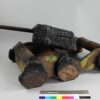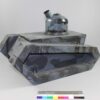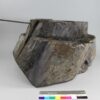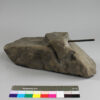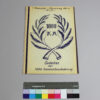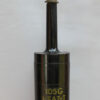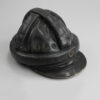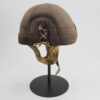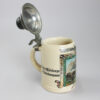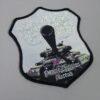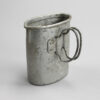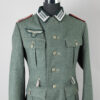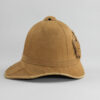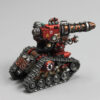Armored sculptures by Gisbert Lange
Inventory number: DPM 7.227-7.239
What makes a tank? How far can its form be reduced so that it is still recognizable? The artist Gisbert Lange explores these questions in his sculptures. He used unusual materials for tanks, not only steel and rubber, but also wood, sheet metal, stone and other found objects. He combined these natural products and remnants found in the forest to create forms that – although only roughly processed – are recognizable as high-tech, mass-produced industrial products. This transfer of the viewer shows how deeply the distinctive shape of these weapons of war is anchored in us: the combination of a rectangular body and an elongated tube already evokes associations with tanks.
Gisbert Lange is a contemporary artist who studied graphic art and painting in Bielefeld and worked in West Berlin and Hamburg. Lange belongs to the first generation born after the war; his life and especially his childhood were still strongly influenced by the war. He grew up with the remnants of the Second World War – traumatized family members, war scrap in the landscape, war toys in the children’s room – and re-enacted what his fathers and grandfathers’ generation might have experienced themselves.
As a young adult, he was influenced by the peace policy debates of 1968, and in 1971 he co-founded the project group “KuPo” (art and politics). Lange frequently addressed the subject of war and soldiering in his works, criticizing the military coup in Chile in 1973, for example, in joint KuPo works, but also tried to approach the German soldiers of the Second World War as individuals in individual works.
In exhibitions, he juxtaposed the 13 tank sculptures, reduced to toy size, with abstract, oversized portrait paintings based on passport photos of unknown soldiers. Some of the 13 differently sculpted tank sculptures are reminiscent of models such as the FT-17, Tiger or T-34, but their diversity is not intended to refer to specific vehicles, but rather to the tank as a symbol of war and its fascination as a children’s toy. Lange’s work is thus a striking example of the post-war generation’s attempt to come to terms with the past. Although they grew up with the remnants of the World War, they were left alone with their interpretation of it for a long time. It was only when this generation demanded a conversation with their parents’ generation in the 1960s and 1970s that family traumas, individual responsibility and questions of guilt could be discussed. Lange’s work thus impressively represents the tension between the fascination with military technology and the use of violence in games and the need to come to terms with one’s own history through art.
Object of the month
(short) stories from the depot
Unfortunately, many objects cannot currently be shown in the exhibition for conservation reasons. Here you will find unusual objects and exciting stories of special pieces from the depot


